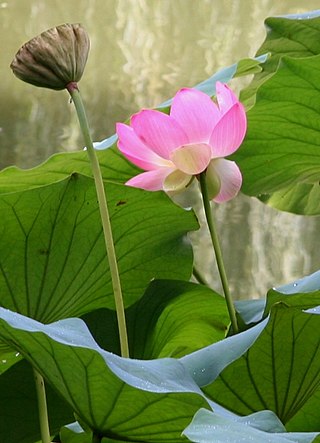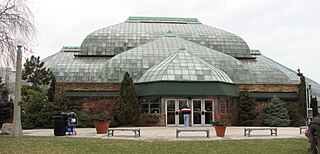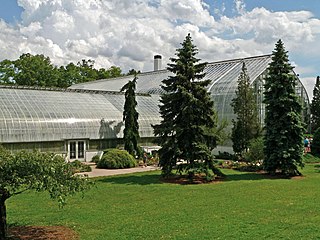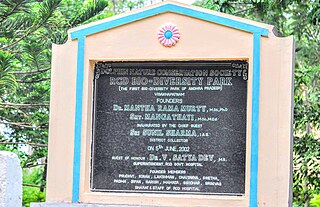
The United States Botanic Garden (USBG) is a botanical garden on the grounds of the United States Capitol in Washington, D.C., near the James A. Garfield Monument.

The Harry P. Leu Gardens are semi-tropical and tropical gardens in Orlando, Florida, United States. The gardens contain nearly 50 acres (200,000 m2) of landscaped grounds and lakes, with trails shaded by 200-year-old oaks and forests of camellias. They are open to the public. The address is 1920 North Forest Avenue Orlando, FL 32803.

The University of California Botanical Garden is a 34-acre botanical garden located on the University of California, Berkeley campus, in Strawberry Canyon. The garden is in the Berkeley Hills, inside the city boundary of Oakland, with views overlooking the San Francisco Bay. It is one of the most diverse plant collections in the United States, and famous for its large number of rare and endangered species.

The Marie Selby Botanical Gardens is a 15-acre (6.1 ha) botanical garden located at 900 South Palm Avenue in Sarasota, Florida. The Gardens are located on the grounds of the former home of Marie and William Selby. The Gardens acquired the Historic Spanish Point campus on May 1, 2020.
The Marie Selby Botanical Gardens is a Smithsonian affiliate, and is accredited by the American Alliance of Museums.

Phipps Conservatory and Botanical Gardens is a botanical garden set in Schenley Park, Pittsburgh, Pennsylvania, United States. It is a City of Pittsburgh historic landmark and is listed on the National Register of Historic Places.

Ganna Walska Lotusland, also known as Lotusland, is a non-profit botanical garden located in Montecito, near Santa Barbara, California, United States. The garden is the historic estate of Madame Ganna Walska. The County of Santa Barbara restricts visitation via a conditional use permit: Lotusland botanic garden is open to the public by reservation only, with walking tours 1½ to 2 hours long.

Oak Park Conservatory is a conservatory and botanical garden located at 615 Garfield Street in the Chicago suburb of Oak Park, Illinois, United States. It is open daily with restricted hours; admission is free, but a donation is suggested.

The University of Illinois Conservatory and Plant Collection is a 2,000-square-foot (190 m2) conservatory and botanical garden located in the Plant Sciences Laboratory Greenhouses, on the University of Illinois at Urbana–Champaign campus, 1201 South Dorner Drive, Urbana, Illinois. The conservatory is generally open to the public daily when the university is in session, though it may be closed for classes, research, or special events.

The Lincoln Park Conservatory is a conservatory and botanical garden in Lincoln Park in Chicago, Illinois. The conservatory is located at 2391 North Stockton Drive just south of Fullerton Avenue, west of Lake Shore Drive, and part of the Lincoln Park, Chicago community area. The Alfred Caldwell Lily Pool and the North Pond Nature Sanctuary are further to the north along Stockton Drive. Along with the Garfield Park Conservatory on Chicago's west side, the Lincoln Park Conservatory provides significant horticultural collections, educational programs and community outreach efforts.

Franklin Park Conservatory and Botanical Gardens is a botanical garden and conservatory located in Columbus, Ohio. It is open daily and an admission fee is charged. Today, it is a horticultural and educational institution showcasing exotic plant collections, special exhibitions, and Dale Chihuly artworks.

The Irwin M. Krohn Conservatory is a conservatory located in Eden Park within Cincinnati, Ohio in the United States.

The San Antonio Botanical Garden is a 38-acre (150,000 m2), non-profit botanical garden in San Antonio, Texas, United States, and the city's official botanical garden.

The Old Botanical Garden of Göttingen University, with an area of 4.5 hectares, is an historic botanical garden maintained by the University of Göttingen. It is located in the Altstadt at Untere Karspüle 1, adjacent to the city wall, Göttingen, Lower Saxony, Germany, and open daily.

The Botanischer Garten München-Nymphenburg is a botanical garden and arboretum in Munich, Germany.

The Gruson-Gewächshäuser, more formally known as the Gruson-Gewächshäuser Magdeburg Exotische Pflanzensammlung, is a botanical garden located in greenhouses at Schönebecker Strasse 129 b, Magdeburg, Saxony-Anhalt, Germany. They are open daily except Monday.

The Enid A. Haupt Conservatory is a greenhouse at the New York Botanical Garden (NYBG) in the Bronx, New York, United States. The conservatory was designed by Lord & Burnham Co. in the Italian Renaissance style. Its major design features are inspired by the Palm House at the Royal Botanic Gardens at Kew, and Joseph Paxton's Crystal Palace.

Allan Gardens is a conservatory and urban park located in the Garden District of Toronto, Ontario, Canada. The property includes a playground, off-leash dog park, and a 1,500 square metres (16,000 sq ft) conservatory with six green houses.

The Anna Scripps Whitcomb Conservatory is a greenhouse and a botanical garden located on Belle Isle, a 982-acre (397-hectare) island park located on the Detroit River within Detroit, Michigan. While located near the Canada–United States border, the island is entirely within the U.S. The park itself consists of 13 acres of preserved land for the conservatory and its botanical garden.

Biodiversity Park, Visakhapatnam, is a botanical garden, an ex situ conservation park, first of its kind in Visakhapatnam, Andhra Pradesh, India. The park is located in the premises of the Rani Chandramani Devi Government Hospital. It extends over 3 acres (1.2 ha). Dolphin Nature Conservation Society (DNCS), Visakhapatnam, a registered, eco-friendly, non-government organization, has maintained it for 13 years and is now maintaining it in collaboration with the hospital and Visakhapatnam Metropolitan Region Development Authority. The park was inaugurated on 5 June 2002. This park has more than 2,000 species of plants. and has recorded visits by 60 species of birds and 105 species of butterflies. The park has become a "living laboratory" for education, awareness and research for students, and botanists, zoologists and researchers.
The Williams Conservatory is located in Laramie, Wyoming at the campus of the University of Wyoming. It opened in 1994. The main greenhouse is filled with exotic plants from various climates and biomes. The Conservatory is open daily for public and it receives hundreds of visitors each year.























